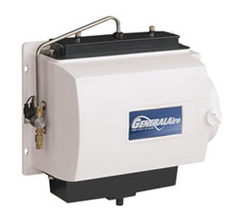 If you’re living in a house that doesn’t have ideal humidiy, you can suffer from a host of health issues. Humidity below 30% is considered severely dry air and can cause respiratory irritation, uncomfortably dry nasal passages, nosebleeds, and chapped and itchy skin. It can also exacerbate conditions such as allergies and asthma.
If you’re living in a house that doesn’t have ideal humidiy, you can suffer from a host of health issues. Humidity below 30% is considered severely dry air and can cause respiratory irritation, uncomfortably dry nasal passages, nosebleeds, and chapped and itchy skin. It can also exacerbate conditions such as allergies and asthma.
Your home and objects in it will also be affected by dry air. It will suck moisture out of porous materials like wood and can cause splitting and cracking. If you have hardwood floors this can be a big issue. Your home and its contents can benefit from careful humidifying, especially wooden musical pieces such as pianos, violins and cellos, antique furniture and even moldings and other woodwork.
What is the best level of humidity to maintain? 30-50% is optimal for most people. During cooler months when you’re running your heating system, you will need to run your humidifier too. Dry air problems are exacerbated when the heat is on because of the nature of the heating units and how they draw moisture from the air. There are two basic types of humidifying systems: a whole-house unit, typically connected to your furnace blower, and the portable or “room” unit.
Whole-House Humidifiers:
A whole home humidifier is installed by professionals and integrated into the blower system of your furnace, drawing water directly from your water supply. There are a few different types on the market, including a sprayer that injects mist into the airflow inside your ductwork and a foam cylinder that rotates in a water tray, with air blowing through and around it.
Pros:
A whole home system does not require very much maintenance and takes care of your entire home. You set it and forget it. Because it draws water from your plumbing system, you never have to fill it or worry that it’s not working because it’s run dry. It’s virtually soundless, and initial cost is a fraction of what most portable units cost. In addition, most whole-house humidifiers literally cost pennies per year to operate.
Cons:
They are not as easy to set up as portable models; it’s best to let a professional handle the installation. They also tend to collect mineral deposits, depending on the local water supply, and will need a thorough cleaning with diluted white vinegar at the end of the heating season before the deposits harden and become difficult to remove.
Portable Humidifiers:
These are freestanding units that plug into regular electrical outlets. They can usually handle one or two rooms at a time and need to have their own water supply. Small, desktop models are available, too, but don’t expect a wide coverage area, just enough to keep you comfortable in your cubicle at work.
Pros:
You can move them! They are convenient because you can use them only where you need them. You can move the unit anywhere you need it: to a bedroom at night or a living area during the day. It’s perfect for renters who can’t install a whole-house unit, and when it’s time to move, the humidifier goes, too. They’re simple to operate and do a good job of keeping a smaller area humidified.
Cons:
High quality portables are usually much more expensive than a whole home solution. They are heavy and even though they usually have wheels, it’s not a simple task to take one up and down stairs.
They are also a little noisy, a lot like a window air conditioning unit. Maintenance is the biggest negative aspect to the portable units; depending on your settings and how large an area you need to humidify, you may find you have to fill the water reservoir almost daily. Most units have removable tanks, but with others, you’ll have to bring the water to the unit.
